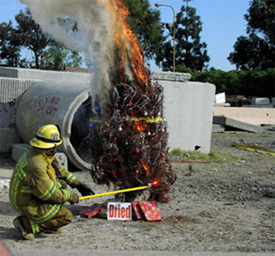December 11, 2006
Deck the Halls—Safely!

By Michael D. Shaw
Let’s modify that “ancient Yuletide carol” for just a moment:
‘Tis the season to be safe!
Each year, countless homeowners risk ruining this joyous time by creating a massive fire hazard with the Christmas tree they have overloaded with lights, tinsel, ribbons, ornaments, electrical cords, and candles. These trees can become excessively dry and will catch fire with surprising ease, causing serious personal injury and even death in far too many cases.
Sadly, from 2000 to 2004, one out of every 22 Christmas tree fires in homes resulted in death, according to the National Fire Protection Association (NFPA). These statistics are particularly stark when you consider that, on average, live and artificial Christmas trees are the ignition sources of 310 reported U.S. home structure fires each year, resulting in 14 fatalities, 40 injuries and $16.8 million in property damage.
The NFPA adds that these statistics are based on fires that started with Christmas trees and do not include fires starting with other products. A small fire that spreads to a Christmas tree can very quickly become large.
Yet, the vast majority of these fires are preventable, if people would only employ a bit of common sense, and avoid the very excesses that cause these problems in the first place.
Failure to properly water these trees, coupled with faulty electrical wiring and simple negligence, sets the stage for potential disaster. Thankfully, there are number of measures that can safeguard against these threats.
Bear in mind that these fires almost always start in the living room, den, or family room. Even worse, these trees are usually near a fireplace, which, while furthering the decorative look of Christmas, is another huge mistake. Hence the annual plea from firefighters and public health officials to keep open flames or heat sources away from trees and other combustible materials, such as wrapping paper, ribbons, greenery, and bows.
The statistics tell us that around 16 percent of these fires begin because a heat source is too close to the tree; an additional 9 percent are started by children (or others) playing with fire or another heat source. Even worse, approximately 33 percent of Christmas tree fires are started by bulbs, lamps or lighting; another 25 percent are started by cords or plugs.
Perhaps the easiest and safest way to avoid these fires is to select a fresh tree. If a lot of needles fall when you move the tree to inspect it, the tree is too dry and is a serious fire hazard. Most importantly, cut off part of the trunk (the so-called fresh cut) and put the tree in a sufficient amount of water (at least one gallon) to prevent dryness.
Expanding on the fireplace admonition above, be sure to place your tree well away from radiators, kerosene heaters, and any other heat source that might dry the tree out or accelerate a serious blaze.
Of course, an excessive amount of fallen needles around the tree when it is in your home is a telltale sign of dryness, and probably means that the tree should be removed. For reasons having to do with family traditions, many people seem to like to purchase their trees too early, virtually assuring tinder box conditions upon Christmas itself.
If we take some pages from the liturgical calendar, a more prudent course might be to bring a fresh tree into the house between the second and third Sundays of Advent [this year, that would be December 10-December 17]. Customs vary regarding how long the tree should stay up, but this is determined for many folks now by trash/recycling collection schedules.
Beyond the dryness issue, one has to consider tree lighting. The tendency to overload trees with lights, connected by old and fraying cords, can create another potential disaster. It is important that homeowners inspect strands of lights for exposed or damaged wires that could ignite a Christmas tree. Loose connections or broken sockets can also be a threat, not to mention extension cords that run under carpets, across doorways, or near heaters.
Finally, never place candles on or near your Christmas tree.
Christmas should be a time of joy, reflection, and spiritual uplift. No doubt, a Christmas tree can be a wonderful symbol of these same principles. However, that requires a degree of restraint, a form of taste over excess and extreme indulgence. Decorate your tree with decorum, not decadence.
Celebrate this holiday season with safety and common sense, and it will truly be a wonderful time. Merry Christmas!

